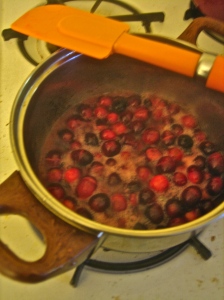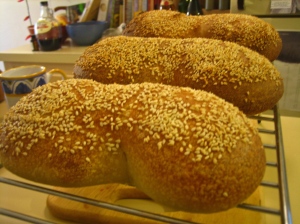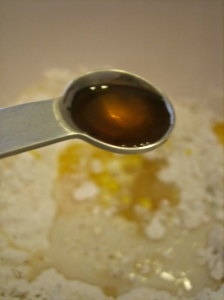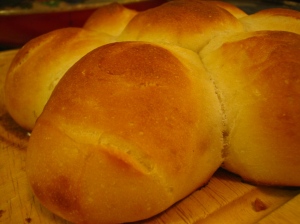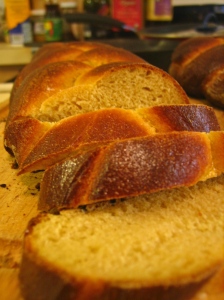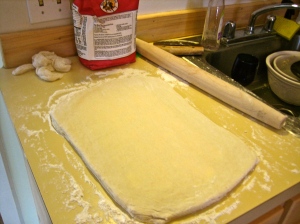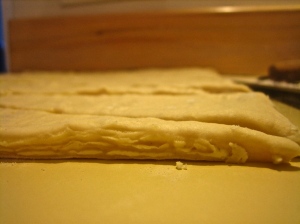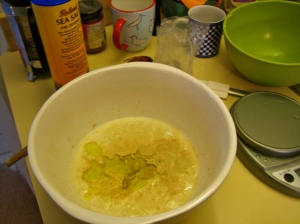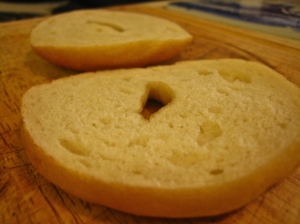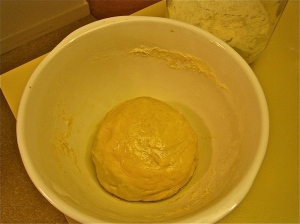Well, my “brief haitus” clearly turned into something more like a sabbatical. If this blog were a bit of dough, I would say it has been subjected to a lengthy fermentation, and, although now severely overproofed, is being resurrected.
Since I had to roll with my bready momentum lest I risk losing it altogether, I decided to make a straight dough–no messing about with paté fermentée, sourdough, or any other process requiring more than a day’s wait for a preferment. Since a restricted time frame always results in a dough with significantly less flavor development, I decided to go the route of extreme flavor enrichment, and threw just about everything into the bowl, including sweet potatoes and cranberries. Clearly, the Israelites were not noshing on sweet potato cranberry challah during the Exodus, but challah is really only intended to symbolize the gift of food sent down from the heavens during this period of time, and the bounty that rained down on my kitchen on this particular day was of the sweet potato and cranberry variety. And so I threw tradition out the window but maintained the general sentiment of gratefulness for the plentiful foods in my life as I made my not-remotely-kosher challah.
I based my dough upon Hamelman’s challah recipe in Bread–adjusting quantities as necessary to accommodate the liquid content of my ridiculous added ingredients–and just generally mucked about with the recipe to make it a bit more rich. Challah often receives some extra special ingredients during the Jewish New Year (hello, raisins!), and seeing as I was celebrating my new year, it felt appropriate to jazz things up a bit.
I began by melting 2 3/4 TB butter in a small pot, to which I added all of the cranberries that had overstayed their welcome in my fridge (about 6 oz. in total) along with 2 TB honey. I cooked this pretty red mixture for a few minutes on medium heat until all the little cranberries burst in the middle, looking like so many people around the Thanksgiving dinner table, loosening their belts to accommodate full bellies.
Into my on-loan KitchenAid I deposited the following ingredients, and began to mix:
2 egg yolks
1 whole egg
8 oz. cooked, mashed sweet potato (thanks, mum!)
the entire cranberry/butter/honey mixture
1 1/2 tsp. salt
1 1/2 tsp. yeast
2 oz. water
roughly 22 oz. flour
About halfway through my preparations, I discovered that my yeast was entirely dead from a series of days spent in a broken refrigerator wasteland. It being New Year’s Eve, I spent a cumulative 30 minutes driving from grocery store parking lot to grocery store parking lot, finding each to be a maddening gridlock of angry, hungry procrastinating party-throwers, crazily dashing in front of moving cars and honking at innocent people like myself who just wanted a teaspoon of yeast, in order to find a coveted and aggressively secured parking space. Uttering a string of unsavory, aggravated noises like a lunatic at every junction of every parking lot, I finally realized that I could just drive to my work and ask nicely for a scant teaspoon of the magical stuff so necessary to the success of my bread, but so detrimental to my original sense of calm.
This was the first time I’ve ever kneaded bread dough in a mixer, and when I finally got around to mixing, I found it difficult to judge when I had added enough flour, and when I had mixed the dough sufficiently, without having my hands on the dough the entire time to judge by feel. The dough appeared very sticky initially, and I found myself adding way more flour than I had originally intended, although perhaps I simply misjudged the significant liquid content of both the cranberries and the sweet potato. The dough was ultimately subjected to about 8 minutes under the tyranny of the dough hook before I pulled the distinctly pinkish mass out of the mixing bowl and set it into another bowl to rise. After an hour rising at room temperature, I punched the dough down, covered it, and set it in the now-functioning refrigerator to develop overnight.
The following evening, I pulled the dough out of the fridge, divided it into four pieces, shaped these pieces into two individual two-stranded loaves, and brushed each loaf with an egg wash before leaving them to proof.
I got a little carried away with hours upon hours of proofing, but the loaves performed just fine in the oven, and baked happily away at 380˚ F for perhaps 45 minutes or so, all the while filling the apartment with the distinct and festive smell of baking cranberries. Using my beautiful new homemade peel (thanks pops!) I pulled the loaves off of the piping hot stone and set them to cool before indulging in a midnight bread snack.
The loaves turned out to be quite large, and could perhaps have benefited from the Jewish tradition of sectioning off a piece of dough to burn in the oven as a gift back to the heavens. (Fun fact: the word “challah” comes from the Hebrew word for “portion,” i. e. portioning off a piece of dough. More neat challah history here.) Instead, I ended up sectioning off a piece of dough to munch on in order to make sure that no great disasters had occurred somewhere in between going crazy with my ingredients and overproofing my loaves. The first slice shocked my palate a bit, as the tartness of the cranberries tricked me into thinking I’d made a sourdough somehow. The sweet potato, although absent in any significant flavor addition, created a lovely moist crumb, and the long proofing period lent the dough a very light and airy quality which was quite pleasant. Next time I would add just a touch more honey, and the balance between sweet and tart would be just right. As it is, I am especially enjoying the tartness when paired with cheese, slathered with butter, or perhaps later made into french toast.
All around, a very enjoyable re-entry into the home bread-making realm, and a nice decadent start to the new year, even if I disregarded a few traditions along the way in favor of using up tasty leftovers.

